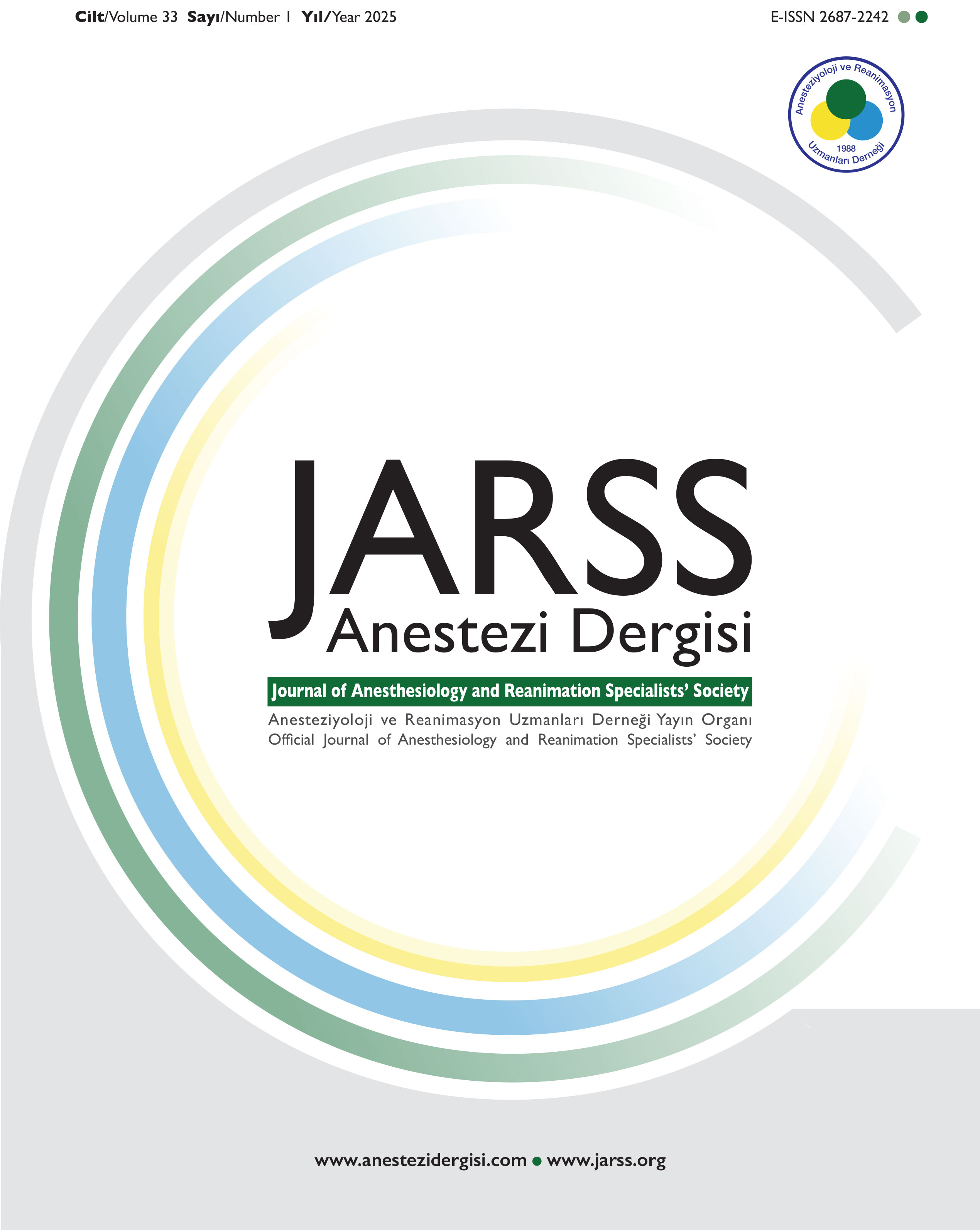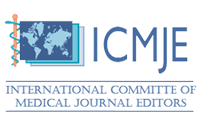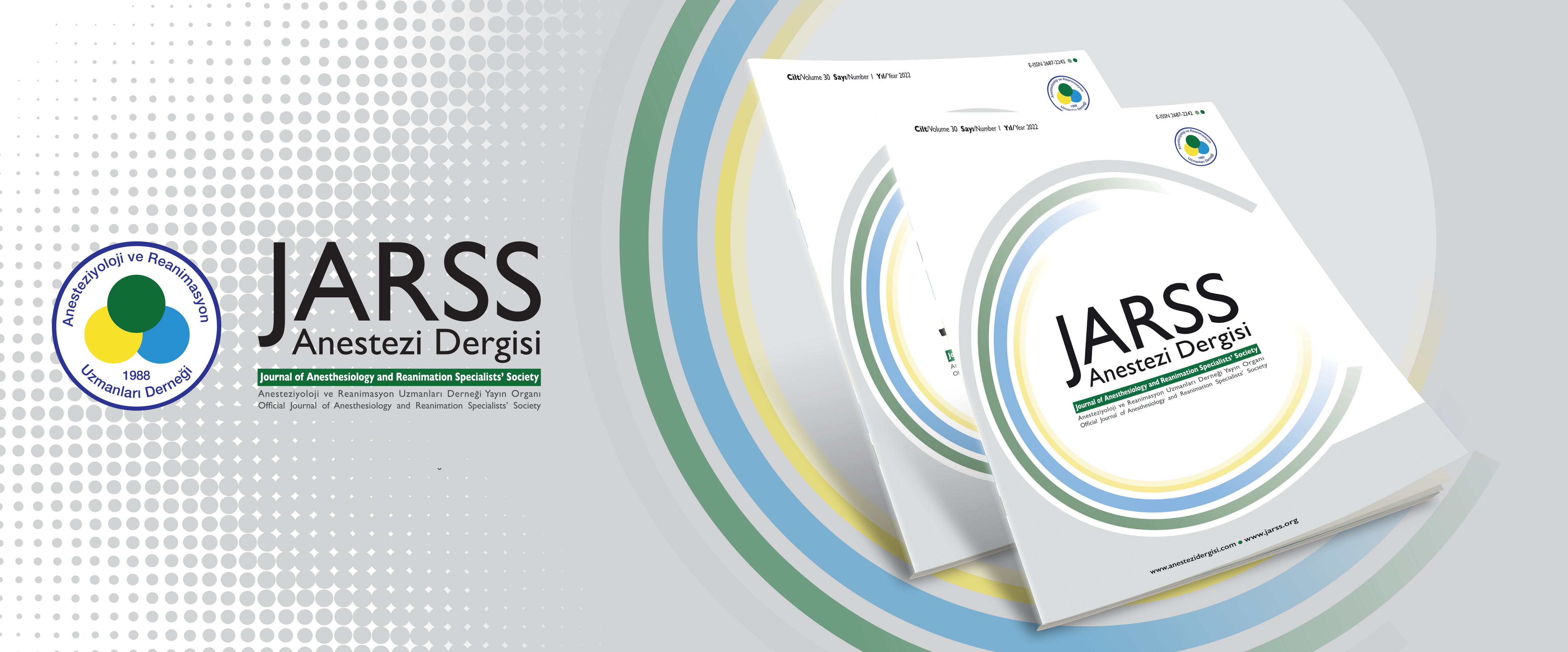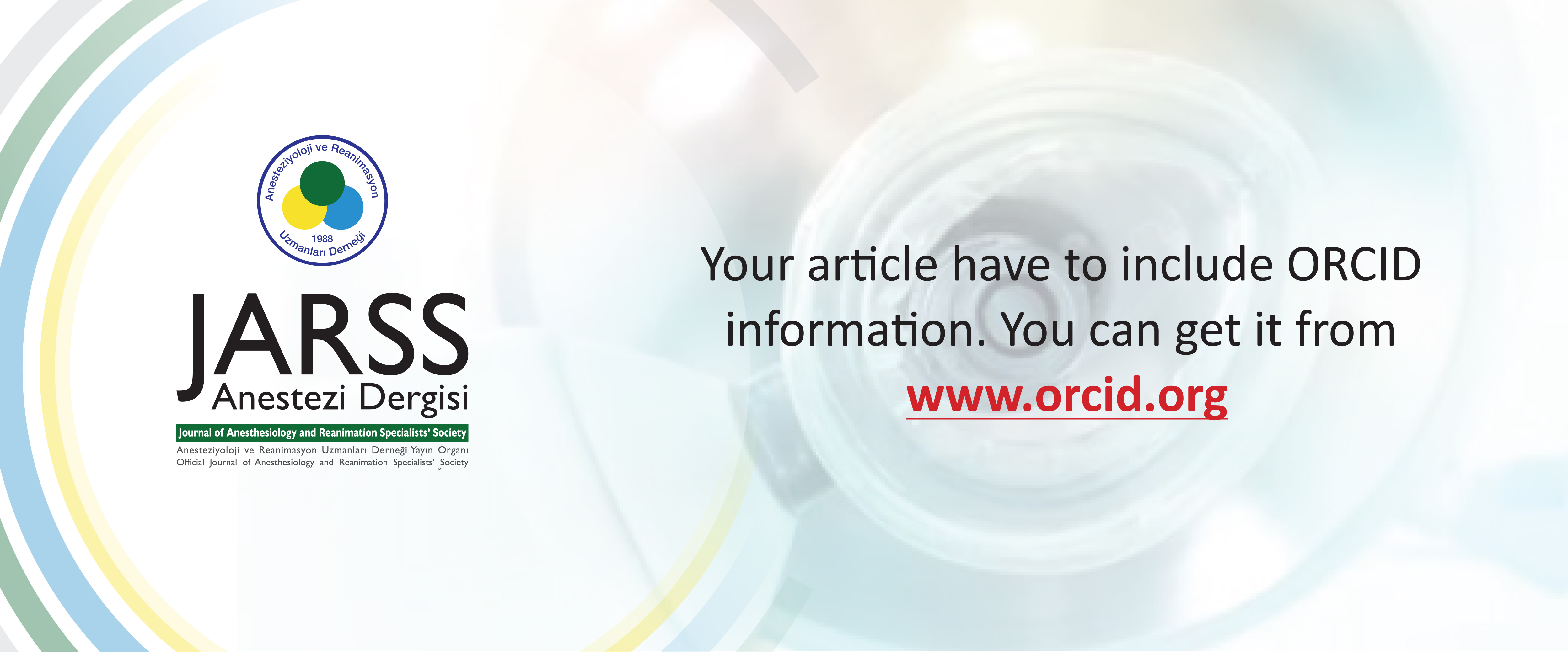Volume: 32 Issue: 2 - 2024
| 1. | Cover Page I (281 accesses) |
| 2. | Advisory Board Pages II - IV (256 accesses) |
| 3. | Contents Pages V - 0 (183 accesses) |
| ORIGINAL RESEARCH | |
| 4. | Anesthetic Management of Mucormycosis Cases Requiring Surgical Debridement Bilge Tuncer, Yasemin Akcaalan, Sumeyye Kocagil, Asena Irem Yildiz, Fulya Celik, Burak Celik, Ezgi Erkilic doi: 10.54875/jarss.2024.48802 Pages 75 - 80 (289 accesses) Objective: Mucormycosis is a rare, progressive, and life-threatening fungal infection that occurs in immunocompromised patients. In the present study, we aimed to evaluate the perioperative challenges in the anesthetic management of mucormycosis patients. Methods: Patients over 18 years of age who underwent surgery for mucormycosis within a 3-year period between January 1, 2020 and December 31, 2022 were included in the study. Perioperative records were retrospectively evaluated. Results: During this period, 25 of 47 cases of mucormycosis were surgically treated. Data from these 25 cases were analyzed. Twelve (48%) patients had a diagnosis of rhinocerebral, 7 (28%) rhino-orbital, 5 (20%) rhino-orbito-cerebral and 1 (4%) rhino-pulmonary mucormycosis. All patients had comorbidities. The most common comorbidities were diabetes mellitus in 20 (80%), followed by hypertension in 12 (48%), acute kidney injury in 7 (28%) and coronary artery disease in 5 (20%) patients. Six (24%) patients had a history of COVID-19 infection and were treated with steroids. Intubation was difficult in 2 (8%) patients. Two (8%) patients had intraoperative hemodynamic instability requiring inotropes. There were 17 (68%) patients, 6 (24%) of whom were intubated, who were transferred to the intensive care unit (ICU). The median length of stay in the ICU was 22.7 days and the total length of stay was 42 days. Eleven (44%) patients required mechanical ventilation. Mortality occurred in 12 (48%) patients. Conclusion: Anesthetic management of surgical debridement for mucormycosis is challenging. Challenges include difficult intubation and renal dysfunction. Postoperative follow-up in the ICU is important due to rapid progression and comorbidities. |
| 5. | Effect of Head Position on Cerebral Oxygen Saturation in Tympanoplasties Performed with Controlled Hypotensive Anesthesia Tankut Uzun, Ahmet Doblan, Nazli Basmaci, Togay Muderris doi: 10.54875/jarss.2024.86648 Pages 81 - 88 (267 accesses) Objective: Our goal was to examine the impact of head position, which had not been examined before, on cerebral oxygenation in tympanoplasties performed in the reverse Trendelenburg position during controlled hypotension. Methods: This prospective study was conducted in our clinic between July 2020 and November 2020. A total of 81 patients aged 18-59 years, who had an ASA physical condition classification score of 1-2 and were evaluated in two groups according to the type of surgery. In the tympanoplasty group, the head was turned to the contralateral ear and placed in minimal extension while in the septoplasty group, the head was kept in the neutral position. The regional cerebral oxygen saturation (c-rSO2) values of the right and left sides were recorded continuously with O3 regional oximetry probes on both sides throughout the operation. Results: When an overall examination was performed without separating the tympanoplasty group as right/left, the median oxygen saturation level was 69.50% (Q1: 61.00-Q3: 72.00) for the operated side and 74.00% (Q1: 66.00-Q3: 79.00) for the contralateral side. The oxygen saturation of the operated side was statistically significant lower (p<0.001). The median oxygen saturation of the operated side in the tympanoplasty group [69.50% (Q1: 61.00-Q3: 72.00)] was statistically significantly lower than that of the septoplasty group [72.00% (Q1: 65.25-Q3: 77.75)] (p=0.004). Conclusion: This study showed that the rotation of the head 45° or above in the revers Trendelenburg supine position causes cerebral desaturation on the opposite side of rotation. |
| 6. | Comparison of the Role of Ultrasound Use in Detecting Lung Pathologies with Prognosis, Mortality and Scoring in Geriatric Critically Ill Patients in the Intensive Care Unit Serpil Bayındır doi: 10.54875/jarss.2024.58219 Pages 89 - 95 (258 accesses) Objective: It is crucial to correctly and promptly diagnose pulmonary diseases and to initiate treatment in elderly patients diagnosed with respiratory failure who are on mechanical ventilator support. The aim of this study is to investigate the effect of lung ultrasound (USG) on prognosis and mortality in geriatric patients we follow up in the intensive care unit, by scoring. Methods: Patients who were followed up in the intensive care unit were grouped as AUSG group (n=48), those who underwent lung USG and NAUSG group (n=74) who underwent chest radiography, computed tomography (CT), magnetic resonance imaging (MRI) or bronchoscopy. The hospital information management system was used to compare the two groups in terms of diagnosis time, number of additional consultations, treatment and discharge time, hospital stay, mortality, and scores. The arterial blood gas analysis, complete blood count, biochemistry, procalcitonin, C-reactive protein, and endotracheal aspirate culture results of the patients were recorded. The clinical pulmonary infection score, pneumonia severity index-65, pulmonary severity index, and acute physiology and chronic health evaluation 2 scores of the groups were compared. Results: The diagnosis time in Group AUSG was 1 ± 0.64 day, the treatment time was 10 ± 4.62 day, and the number of required consultations was 1 ± 0.68, which was significantly lower than in Group NAUSG (p<0.05). The mortality rate was 14 (29.2%) patients in Group AUSG and 25 (33.8%) patients in Group NAUSG (p>0.05). When comparing the scores of the patients, the clinical pulmonary infection score, pneumonia severity index-65 (4 ± 0.79), and pulmonary severity index (3 ± 0.87) were significantly lower in Group AUSG (p<0.05). There was no significant difference in acute physiology and chronic health evaluation 2 scores. Conclusion: Performing lung USG for the diagnosis and treatment of critically ill elderly patients can lead to earlier detection and treatment of lung pathologies, reducing mortality rates, unnecessary imaging and consultations. Its advantages include easy and rapid bedside application and simultaneous results. |
| 7. | The Effects and Comparative Efficacy of Dexamethasone and Gabapentin on Nausea and Vomiting after Laparoscopic Cholecystectomy Gizem Avci, Nilhan Kansu Alemdar doi: 10.54875/jarss.2024.50251 Pages 96 - 102 (276 accesses) Objective: Postoperative nausea and vomiting (PONV) is a common postoperative complication. The aim of this study was to investigate the efficacy of gabapentin and dexamethasone as new treatment strategies in the treatment of PONV. Methods: This retrospective study included a total of 136 ASA I-II patients aged 18-70 years who underwent elective cholecystectomy. Group D (n=66) received 4 mg intravenously dexamethasone after anesthesia induction and Group G (n=70) received 600 mg gabapentin oral treatment. Standard DII and V5 lead ECG, automatic non-invasive blood pressure and peripheral oxygen saturation monitoring was applied to all patients in the general operating room, anesthesia maintenance was provided with total intravenous anesthesia after orotracheal intubation and at the end of surgery, patients were transferred to the postoperative care unit. Nausea and vomiting symptoms, pain scores and the time and dose of additional antiemetic/analgesic requirements in the first 24 hours were monitored. Results: There were no statistically significant demographic differences between the groups and the results showed that both dexamethasone and gabapentin were effective in preventing PONV. The need for rescue antiemetic therapy was similar in both groups (p=0.2). Significantly less postoperative analgesic was required in the gabapentin group than in the dexamethasone group. Conclusion: Antiemetic drug prophylaxis should be administered to patients at high risk of PONV and treatment with different groups of antiemetic drugs should be considered. Dexamethasone and gabapentin can be considered effective drugs for the prevention of PONV. |
| 8. | The Effect of Epibaditine on Renal Ischemia Reperfusion Injury in Rats Ayşe Börklüce, Gökçen Emmez, Gözde İnan, Özlem Gülbahar, Sibel Serin Kilicoglu, Mehmet Serdar Gültekin, Mustafa Bahadır, Tuba Saadet Deveci Bulut, Hasan Kutluk Pampal doi: 10.54875/jarss.2024.05826 Pages 103 - 110 (232 accesses) Objective: The attenuation of renal ischemia reperfusion (I/R) injury by stimulating cholinergic antiinflamatory pathway has been demonstrated in the literature. The purpose of this study is to investigate the protective effects of epibatidine, a non selective nicotinic acethycholine receptor agonist, administered before ischemia on renal ischemia-reperfusion injury. Methods: After Ethics Committee approval, 24 Wistar Albino rats were randomly allocated into 4 groups. Group S: Sham (n=6), Group I/R: Ischemia/reperfusion (n=6), Group I/R-E: Ischemia/reperfusion-Epibatidine (n=6), Group E: Epibatidine (n=6). All groups underwent laparotomy and bilateral renal artery and vein dissection under anesthesia. No further action was taken in Group S. In Group I/R and Group I/R-E, renal ischemia was applied for 25 minutes and then reperfusion for 24 hours. A single dose of 5 µg kg-1 epibatidine was administered subcutaneously before the laparotomy in Group I/R-E and Group E. At the end of the reperfusion period, blood and urine samples were taken for plasma BUN, creatine, plasma and urinary neutrophil gelatinase associated lipocalin (NGAL) and cystatin C, plasma IL-6 and TNF-α assessment. Results: Plasma BUN, creatine, NGAL, cystatin C, IL-6 and TNF-α levels were significantly higher in Group I/R when compared to Group S (p<0.05). All the levels of the above biomarkers were comparable in Group S and Group I/R-E. Conclusion: These results indicate that epibatidine administration before ischemia has a protective effect on kidney in renal I/R injury induced rats. |
| 9. | Evaluation of the Relationship Between Compassion Fatigue, Empathy Tendency, and Job Satisfaction in Nurses Working in Critical Units Başak Ünsal Çimen, Gökçe Durmuş Tosun, Gönül Kapıtaşı, Gamze Onat, Burak Yalçın, Ümmügülsüm Gaygısız, Lale Karabıyık doi: 10.54875/jarss.2024.13471 Pages 111 - 122 (475 accesses) Objective: The stress levels of nurses working in critical units are very high because they have to manage crisis situations and encounter many deaths. Stress and fatigue experienced by nurses; while it leads to insensitivity to the needs of others and a decrease in empathy ability, over time it results in compassion fatigue and a decrease in job satisfaction. In this single-center descriptive survey study, it was aimed to investigate the levels of compassion fatigue, empathy tendency and job satisfaction in nurses working in critical units, and to examine the relationship between them. Methods: A survey study was planned with the participation of nurses working in critical units such as operating rooms, intensive care units and emergency rooms. “Introductory Information Form”, “Compassion Satisfaction Scale”, “Empathic Tendency Scale” and “Job Satisfaction Scale” were used as data collection tools. Results: As a result of this research in which 155 nurses participated; it was determined that there was a statistically significant relationship between the compassion fatigue scale, empathic tendency scale and job satisfaction scale (p<0.05). A negative relationship was determined between the “Compassion Satisfaction Scale” and the “Empathic Tendency Scale” (r= - 0.323; p<0.05), and the “Compassion Satisfaction” and “Job Satisfaction Scale” (r= -0.414 p<0.05). A significant positive relationship was found between the “Empathetic Tendency Scale” and the “Job Satisfaction Scale” (r= 0.446 p<0.05). Conclusion: Compassion fatigue caused by physiological and psychological wear and tear, which is common in nurses working in critical units, results in a decrease in empathy and job satisfaction over time. Stress and the feeling of professional burnout can be reduced by methods such as restricting and regulating working hours in relevant critical departments and improving physical and social conditions. |
| 10. | Ex-Ovo Evaluation of Sevoflurane Exposure on Chick Embryo Development: Investigating Angiogenesis Effects Nadide Ors Yildirim, Omer Faruk Kirlangic, Omer Faruk Kirlangic doi: 10.54875/jarss.2024.83792 Pages 123 - 129 (259 accesses) Objective: Angiogenesis, defined as the formation of new blood vessels from pre-existing ones, plays a vital role in both physiological and pathological conditions. Understanding agents that can influence angiogenesis is crucial in managing diseases where angiogenesis is dysregulated. This study focuses on sevoflurane, a commonly used inhalation anesthetic, whose effects on angiogenesis and embryonic development are not well understood. Our objective was to assess the impact of sevoflurane exposure on angiogenesis using the ex-ovo chick chorioallantoic membrane model. Methods: In this model, fertilized chicken eggs were exposed to sevoflurane at concentrations of 2% and 4%, for varying durations of 1, 2, and 4 hours. The embryos were then divided into control and experimental groups for quantitative angiogenesis assessment using Image J software, followed by statistical analysis with one-way analysis of variance. Results: The results indicate that sevoflurane exposure has a dose-dependent positive effect on angiogenesis, with significant increases in vascular density observed in embryos exposed to both concentrations compared to the control group. Additionally, the length of exposure was found to further enhance these angiogenic effects. Conclusion: Despite the dose and duration-dependent impact of sevoflurane on angiogenesis, the existing literature presents mixed findings, highlighting the need for additional research to elucidate sevoflurane’s role in angiogenesis. This is particularly important for understanding its implications in various medical conditions, such as cancer, wound healing, and fetal development. Future investigations into sevoflurane’s effects on placental angiogenesis could also provide valuable insights into its potential consequences on intrauterine growth. |
| CASE REPORT | |
| 11. | A Misplaced Femoral Venous Catheter in the Internal Iliac Vein: A Case Report Rafet Yarimoglu, Saliha Yarimoglu doi: 10.54875/jarss.2024.97659 Pages 130 - 132 (286 accesses) Central venous catheters are used for many purposes in intensive care. Venous catheterization in the femoral region is safer than others regarding mechanical complications. Although femoral catheter malpositions are rare, they can lead to fatal consequences, especially when diagnosed late. In this article, the misplaced femoral central venous catheter in the internal iliac vein is presented. A 36-year-old male patient diagnosed with respiratory failure displayed septicemia symptoms during his follow-up in the intensive care unit. A blood sample from the central catheter in the right femoral region showed bacterial growth. Therefore, a new central venous catheter was placed into the left femoral vein for an inotropic infusion. According to the abdominal computed tomography scan report performed for a different reason the next day, the catheter was seen in an incorrect position. The evaluation revealed the catheter to be situated in the internal iliac vein. The catheter was removed without complications. We share a report regarding catheter malposition found in the internal iliac vein. Physicians must keep in mind that early detection of catheter malpositions is critical. |
| 12. | An Unusual Complication of a 14 Year-old Port-Catheter Mete Manici, Doruk Yaylak, Yasemin Sincer, Yavuz Gurkan doi: 10.54875/jarss.2024.37233 Pages 133 - 134 (264 accesses) Percutaneous subclavian catheters or port-catheters are commonly used for oncology patients who require long-term or continuous intravenous therapy. There are several reported complications related to port-catheters like arterial puncture, pneumothorax and hematoma. We aimed to report an unusual port-catheter case. Our patient was a 45-year-old male who had a port-catheter inserted after the diagnosis of rectum cancer in 2009 and has never showed up for a catheter removal after his chemotheraphy regimen had been completed. The silicone port of the catheter was found to be disintegrated during the catheter removal procedure. Removal was performed but distal 5 cm of the catheter was missing. At the end of the procedure, control X-ray was obtained, but the last part of the catheter could not be visualized. There are reported cases of pinch-off syndrome in the literature however we couldn’t find any such case as we report. Following port-catheter implantation and throughout the course of treatment, patients should be consistently monitored, and an appropriate time should be scheduled for removal. Physicians should be aware of complications and multidisciplinary approaches should be made to avoid serious events and further harm. |

















